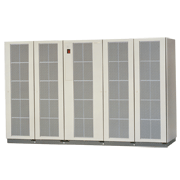Hitachi’s H-6593 and H-6596 disk array subsystems, announced in February 1998, inherited the features of the successful H-6592 / H-6595 series, such as uninterrupted operation and a high degree of scalability, while offering even better performance, reliability, storage capacity, and functionality. Based on experiences with the H-6592 and H-6595, Hitachi made sweeping improvements in performance, scalability, and functionality on both the microprocessor side and the hardware side.
For greater system flexibility to meet a broad range of user needs, the H-6593 and H-6596 supported three types of hard disk drives — the conventional 9 GB drive, a ultra-high-speed 6 GB drive, and a large-storage 18 GB drive, supported various disk array configurations — including RAID-5, RAID-1, and cache resident functionality — and several different host connections, including ACONARC, metal, SCSI, and optical.
- Features of the units:
- (1)Hitachi was successful in overcoming the 10,000 rpm speed barrier with 2.5-inch (6.35-centimeter) disks, which had been impossible to reach before due to heat issues, and developed a 12,030 rpm disk drive with 6 GB capacity. At the same time, Hitachi doubled the drive’s performance by boosting the controller’s internal bus speed and increasing the number of data transfer paths. The H-6593 and H-6596 supported a 9 GB drive and an 18 GB drive to give users greater selection flexibility.
- (2)In addition to the conventional mainframe interfaces and open system interfaces, the H-6593 and H-6596 included a fiber channel, which permitted flexible system arrangements that incorporated long-run interconnections. Besides enabling multiple platform connections, the H-6593 and H-6596 expanded the number of connection paths from the previous 16 paths to 32 paths, thereby making it possible to work in large-scale system environments.
- (3)The H-6593 and H-6596 retained the multiplatform functions found on the H-6592 and H-6595, including Hitachi multiplatform resource sharing (HMRS), Hitachi multiplatform data exchange (HMDE), and Hitachi multiplatform backup/restore (HMBR). The new series also supported a variety of software products, such as a remote copy function for disaster recovery, that made the subsystems more user friendly.
| Parameter | Specification | |
|---|---|---|
| Applicable system | Mainframes | Open systems |
| Host interface | ACONARC/metal channels | SCSI-2/Ultra SCSI/fiber channels |
| Subsystem capacity | 2,943GB | 2,963GB |
| Cache memory | 256MB — 16GB | |
| External dimensions [mm] | 1,268—2,918 x 800 x 1,790 (w x d x h) | |


